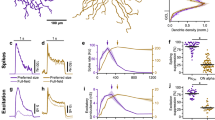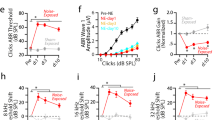Abstract
Following restricted peripheral damage, reorganization of adult sensory or motor cortex is believed to depend on loss of surround inhibition, which unmasks latent inputs to the deprived cortex. Here I demonstrate that limited damage to auditory receptors causes loss of functional surround inhibition in the cortex, unmasking of latent inputs and significantly altered neural coding. However, these changes do not lead to plasticity of the cortical map, defined by the most sensitive input from the receptor surface to each cortical location. Thus, in sensory cortex, loss of surround inhibition as a consequence of receptor organ damage does not necessarily result in cortical map plasticity.
This is a preview of subscription content, access via your institution
Access options
Subscribe to this journal
Receive 12 print issues and online access
$209.00 per year
only $17.42 per issue
Buy this article
- Purchase on Springer Link
- Instant access to full article PDF
Prices may be subject to local taxes which are calculated during checkout



Similar content being viewed by others
References
Merzenich, M.M. et al. Topographic reorganization of somatosensory cortical areas 3b and 1 in adult monkeys following restricted deafferentation. Neuroscience 8, 33–55 (1983)
Kaas, J.H. et al. Reorganization of retinotopic cortical maps in adult mammals after lesions of the retina. Science 248, 229– 231 (1990)
Darian-Smith, C. & Gilbert, C.D. Topographic reorganization in the striate cortex of the adult cat and monkey is cortically mediated. J. Neurosci. 15, 1631–1647 (1995)
Robertson, D. & Irvine, D.R.F. Plasticity of frequency organization in auditory cortex of adult guinea pigs with partial unilateral deafness. J. Comp. Neurol. 282, 456–471 (1989)
Rajan, R., Irvine, D.R.F., Wise, L.Z. & Heil, P. Effect of unilateral partial cochlear lesions in adult cats on the representation of lesioned and unlesioned cochleas in primary auditory cortex. J. Comp. Neurol. 338, 17–49 ( 1993)
Sanes, J.N., Suner, S. & Donoghue, J.P. Dynamic organization of primary motor cortex output to target muscles in adult rats. I. Long-term patterns of reorganization following motor or mixed peripheral nerve lesions. Exp. Brain Res. 79, 479–491 (1990)
Hendry, S.H.C. & Jones, E.G. Reduction in number of immunostained GABAergic neurones in deprived-eye dominance columns of monkey area 17. Nature 320, 750–753 ( 1986)
Hendry, S.H.C. & Kennedy, M.B. Immunoreactivity for a calmodulin-dependent protein kinase is selectively increased in macaque striate cortex after monocular deprivation. Proc. Natl Acad. Sci. USA. 83, 1536–1540 (1986)
Warren, R., Tremblay, N. & Dykes, R.W. Quantitative study of glutamic acid decarboxylase-immunoreactive neurones and cytochrome oxidase activity in normal and partially deafferented rat hindlimb somatosensory cortex. J. Comp. Neurol. 288, 583–592 (1989)
Welker, E., Soriano, E. & van der Loos, H. Plasticity in the barrel cortex of the adult mouse: effects of peripheral deprivation on GAD-immunoreactivity. Exp. Brain Res. 74, 441–452 ( 1989)
Hendry, S.H.C., Fuchs, J., deBlas, A.L. & Jones, E.G. Distribution and plasticity of immunocytochemically localized GABAA receptors in adult monkey visual cortex. J. Neurosci. 10, 2438–2450 (1990)
Garraghty, P.E., LaChica, E.A. & Kaas, J.H. Injury-induced reorganization of somatosensory cortex is accompanied by reductions in GABA staining. Somatosens. Motor Res. 8, 347–354 ( 1991)
Calford, M.B. & Tweedale, R. Immediate and chronic changes in responses of somatosensory cortex in adult flying-fox after digit amputation . Nature 332, 446–448 (1988)
Jacobs, K.M. & Donoghue, J.P. Reshaping the cortical motor map by unmasking latent intracortical connections. Science 251, 944–947 (1991)
Wall, J.T. Variable organization in cortical maps of the skin as an indication of the lifelong adaptive capacities of circuits in the mammalian brain. Trends Neurosci. 11, 549–557 (1988)
Rausell, E., Cusick, C.G., Taub, E. & Jones, E.G. Chronic deafferentation in monkeys differentially affects nociceptive and nonnociceptive pathways distinguished by specific calcium-binding proteins and down-regulates γ-aminobutyric acid type A receptors at thalamic levels. Proc. Natl Acad. Sci. USA 89, 2571–2575 ( 1992)
Rasmusson, D.D., Webster, H.H. & Dykes, R.W. Neuronal response properties within subregions of raccoon somatosensory cortex 1 week after digit amputation. Somat. Motor Res. 9, 279–289 ( 1992)
Jones, E.G. GABAergic neurones and their role in cortical plasticity in primates. Cereb. Cortex 3, 361–372 ( 1993)
Donoghue, J.P. Plasticity of adult sensorimotor representations. Curr. Opin. Neurobiol. 5, 749–754 (1995)
D'Amelio, F., Fox, R.A., Wu, L.C. & Daunton, N.G. Quantitative changes of GABA-immunoreactive neurons in the hindlimb representation of the rat somatosensory cortex after 14-day hindlimb unloading by tail suspension . J. Neurosci. Res. 44, 532– 539 (1996)
Sillito, A.M. The contribution of inhibitory mechanisms to the receptive field properties of neurones in the striate cortex of the cat. J. Physiol. 250, 305–329 (1975)
Ramoa, A.S., Paradiso, M.A. & Freeman, R.D. Blockade of intracortical inhibition in kitten striate cortex: effects on receptive field properties and associated loss of ocular dominance plasticity. Exp. Brain Res. 73, 285–296 (1988)
Dykes, R.W., Landry, P., Metherate, R. & Hicks, T.P. Functional role of GABA in cat primary somatosensory cortex: shaping receptive fields of cortical neurons. J. Neurophysiol. 52, 1066– 1093 (1984)
Batuev, A.S., Alexandrov, A.A., Scheynikov, N.A., Kcharazia, V.N. & An, C.C. The role of inhibitory processes in the formation of functional properties of neurons in vibrissal projection zone of the cat somatosensory cortex. Exp. Brain Res. 76, 198–206 (1989)
Alloway, K.D., Rosenthal, P. & Burton, H. Quantitative measurements of receptive field changes during antagonism of GABAergic transmission in primary somatosensory cortex of cats. Exp. Brain Res. 78, 514–532 (1989)
Rajan, R., Irvine, D.R.F. & Cassell, J.F. Normative N1 audiogram data for the barbiturate-anaesthetised domestic cat. Hearing Res. 53, 153– 158 (1991)
Volkov, I.O. & Galazjuk, A.V. Formation of spike response to sound tones in cat auditory cortex neurons: interaction of excitatory and inhibitory effects. Neuroscience 43, 307 –321 (1991)
Schreiner, C.E. & Mendelson, J.R. Functional topography of cat primary auditory cortex: distribution of integrated excitation. J. Neurophysiol. 64, 1442–1459 (1990)
Vater, M., Habbicht, H., Kössl, M. & Grothe, B. The functional role of GABA and glycine in monaural and binaural processing in the inferior colliculus of horseshoe bats. J. Comp. Physiol. A 171 , 541–553 (1992)
Yang, L., Pollak G.D. & Resler, C. GABAergic circuits sharpen tuning curves and modify response properties in the mustache bat inferior colliculus. J. Neurophysiol. 68, 1760–1774 (1992)
Pollak G.D. & Park, T.J. The effects of GABAergic inhibition on monaural response properties of neurons in the mustache bat's inferior colliculus. Hearing Res. 65, 99– 117 (1993)
Calford, M.B. & Semple, M.N. Monaural inhibition in cat auditory cortex. J. Neurophysiol. 73, 1876– 1891 (1995)
Calford M.B. & Tweedale, R. Acute changes in cutaneous receptive fields in primary somatosensory cortex after digit denervation in adult flying fox. J. Neurophysiol. 65, 178– 187 (1991)
Calford M.B. & Tweedale, R. C-fibres provide a source of masking inhibition to primary somatosensory cortex. Proc. Royal Soc. Lond. B 243, 269–275 ( 1991)
Rasmusson, D.D., Louw, D.F. & Northgrave, S.A. The immediate effects of peripheral denervation on inhibitory mechanisms in the somatosensory thalamus. Somatosens. Motor Res. 10, 69–80 ( 1993)
Kiang, N.Y.-S., Watanabe, T., Thomas, E.C. & Clark, L.F. Discharge Patterns of Single Fibers in the Cat's Auditory Nerve (M.I.T. Press, Cambridge, Massachusetts, 1965)
Liberman, M.C. Auditory-nerve response from cats raised in a low-noise chamber. J. Acoustic Soc. Am. 63, 442–455 ( 1978)
Evans, E.F. & Palmer, A.R. Relationship between the dynamic range of cochlear nerve fibres and their spontaneous activity. Exp. Brain Res. 40, 115–118 (1980)
Liberman, M.C. Physiology of cochlear efferent and afferent neurons: direct comparisons in the same animal. Hearing Res. 34, 179– 192 (1988)
Manley, G.A. & Robertson, D. Analysis of spontaneous activity of auditory neurones in the spiral ganglion of the guinea-pig cochlea. J. Physiol. 258, 323–336 (1976)
Schmiedt, R.A. Spontaneous rates, thresholds and tuning of auditory-nerve fibers in the gerbil: comparisons to cat data. Hearing Res. 42, 23– 36 (1989)
Acknowledgements
This study was supported by grant No. 941006 from the National Health and Medical Research Council of Australia.
Author information
Authors and Affiliations
Corresponding author
Rights and permissions
About this article
Cite this article
Rajan, R. Receptor organ damage causes loss of cortical surround inhibition without topographic map plasticity. Nat Neurosci 1, 138–143 (1998). https://doi.org/10.1038/388
Received:
Accepted:
Issue Date:
DOI: https://doi.org/10.1038/388
This article is cited by
-
Apoptotic mechanisms after repeated noise trauma in the mouse medial geniculate body and primary auditory cortex
Experimental Brain Research (2017)
-
Tinnitus: perspectives from human neuroimaging
Nature Reviews Neuroscience (2015)
-
Tinnitus: animal models and findings in humans
Cell and Tissue Research (2015)
-
Tonotopic reorganization and spontaneous firing in inferior colliculus during both short and long recovery periods after noise overexposure
Journal of Biomedical Science (2013)
-
Noise-Induced Inner Hair Cell Ribbon Loss Disturbs Central Arc Mobilization: A Novel Molecular Paradigm for Understanding Tinnitus
Molecular Neurobiology (2013)



